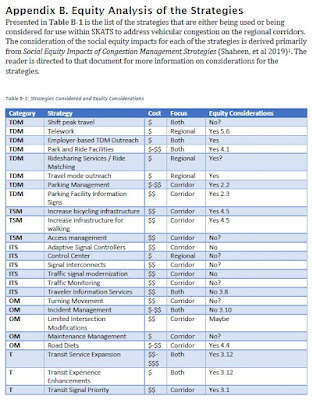The Policy Committee for our Metropolitan Planning Organization meets on Tuesday the 27th, and they'll consider the Congestion Management Process.
 |
| Oregonian, earlier this month |
At last month's meeting, it appears they decided to ditch any evaluation of projects for climate impacts.
 |
| Bailing on scoring for GHG emissions |
That is a real refusal and failure. It is also a consequence of the anti-urban, non-representative bias of the Policy Committee, which gives excessive weight to ruralish County and small town interests.
 |
| From an SR2S analysis of MPOs (2019) |
If we apportioned votes by population, we would have a different governing structure. In our transportation planning, voting weights on the Policy Committee are a lesser example of the right-wing slogan, "we are a Republic, not a Democracy"! Our Metropolitan Planning Organization is structured specifically with anti-urban, non-democratic bias.
 |
| Proportions in the SKATS area |
In the table each jurisdiction gets one vote, and the requirement in some cases, custom in all the other cases, for unanimous votes on the Policy Committee means small or non-urban jurisdictions have veto power. That was a feature, not a bug.
 |
| via Twitter |
This is a real structural problem with the MPO, and by design encodes an anti-urban politics.
Congestion Management Process
 |
| The CMP agenda item |
This month the MPO looks to adopt a Congestion Management Process and plan.
The plan is constrained and shaped by Federal requirements, and there are real limits to how much it might be altered. Still, it fundamentally talks around things that would actually reduce congestion and focuses instead on symbolic actions that look like they might reduce congestion.
 |
| "congestion pricing...main candidate tool" American Economic Review |
But even things like "parking cash-outs," which are explicitly identified in Federal regulations as useful have not been very much stressed.
 |
| Have we seen any emphasis on parking cash-outs? |
The Process identifies "regional corridors of interest," which are our busy highways and arterials. (And also overlaps the protected bike lane proposal.)
 |
| The Corridors of Interest |
 |
| "complete facilities" |
It says "many also have complete facilities for walking and biking," but that technical, pro-forma definition of "complete" does not mean inviting or broadly useful. They are in nearly every case old-school facilities, no longer considered best practice. The discussion focuses on the theoretical existence of choice, and not on the actual employment of choice.
 |
| Theoretical choice on paper, not actual choices |
Fortunately, some of the members of the Committee understand that a blue line on a map of bike lanes does not make an actual travel choice. Last month in a discussion on goal setting and whether to use aspirational goals or trend-line goals, the Cherriots representive rightly pointed out that "the desire to walk or ride bicycles is often dependent on have safe facitilies...." We should measure what people actually do, and if old-school facilities aren't inviting enough, we should upgrade them so we attain our policy goals. Our goals should be more prescriptive than simply descriptive.
 |
| Good facilities are necessary to make choice actual |
Though the Process and plan nods to more modern approaches to congestion, it has not caught up to climate and emissions, and still emphasizes "bottleneck removal" and "roadway expansion."
 |
| Too much on capacity increase |
In an appendix it discusses Equity, and if we can do that we can also include emissions.
 |
| If we can look at equity, we can look at emissions and induced demand |
As a footnote, over the life of this blog it has been debated whether going from a two-lane "unimproved" road with only shoulders to an "urban upgrade" with two travel lanes, a center turn lane, sidewalks, and bike lanes constitutes a capacity increase. The position here is that it is a capacity increase.
The plan confirms this, saying a "minor roadway expansion" with adding a center turn lane is a capacity increase. We should be able to regard this as settled now.
 |
| A center turn lane is a capacity increase |
The Policy Committee meets at noon on Tuesday the 27th. The meeting packet and agenda can be downloaded here.
 |
| Meeting information |


1 comment:
Regarding the governing structure, I want readers to know that in addition to the elected officials from the 5 jurisdictions (Salem, Keizer, Turner, Marion county and Polk county) the SKATS Policy Committee also includes a member of the Salem-Keizer (Cherriots) Transit Board, a member from the Salem-Keizer School District Board, and an ODOT representative.
Mike Jaffe
Transportation Planning Director
Mid-Willamette Valley Council of Governments
Post a Comment